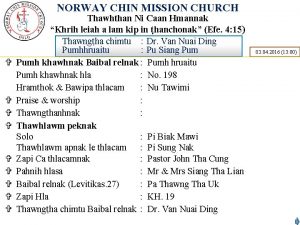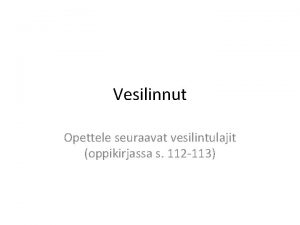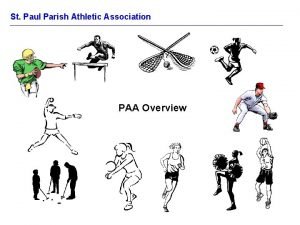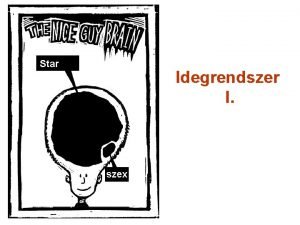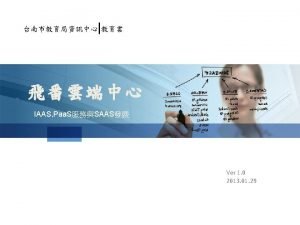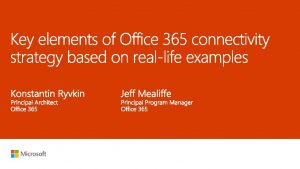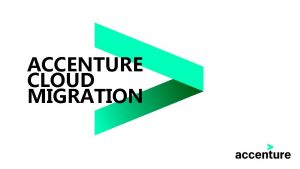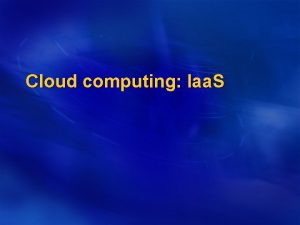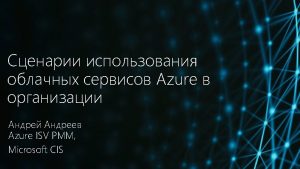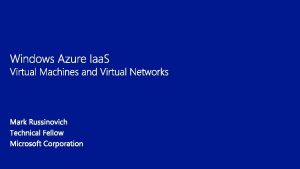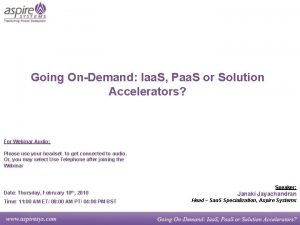Ensure Cloud Security in Iaa S Paa S












- Slides: 12

Ensure Cloud Security in Iaa. S, Paa. S, and Saa. S Environments Keep your information security risks manageable when leveraging the benefits of cloud computing. Info-Tech Research Group Inc. is a global leader in providing IT research and advice. Info-Tech’s products and services combine actionable insight and relevant advice with Info-Tech's products and services combine actionable insight and relevant advice with ready-to-use tools and templates that cover the full spectrum of IT concerns. © 1997 -2019 Info-Tech Research Group Inc. Info-Tech Research Group 1

Our understanding of the problem This Research Is is Designed For: This Research Will Help You: üCISOs üSecurity directors and managers üProject managers üIdentify the cloud risk profile and security control gaps that must be covered. üEnsure the organization’s cloud environment is secured and protected from data leaks and breaches. Ensure privacy of data and other information is maintained. üLeverage the security capabilities from cloud vendors. This Research Will Also Assist: This Research Will Help Them: You: üVendor management üSecurity architects üBusiness managers üFactor security’s needs into the contract with a cloud service provider (CSP). üAddress security’s needs in the project plan for configuration of the software and for supporting technology. üPut an ongoing program in place to manage the CSPs and monitor security controls. SAMPLE Info-Tech Research Group 2

Executive summary Situation • Cloud environments, such as infrastructure as a service (Iaa. S), platform • as a service (Paa. S), or software as a service (Saa. S) offer major IT and business benefits that organizations are looking to realize. An organization has decided to migrate some part of the business into a cloud environment. This is being done for numerous cloud rationales. Complication • Security remains a large impediment to realizing cloud benefits. • Numerous concerns still exist around the ability for data privacy, confidentiality, and integrity to be maintained in a cloud environment. Even if adoption is agreed upon, it becomes hard to evaluate vendors that have strong security offerings and even harder to utilize security controls that are internally deployed in the cloud environment. 1. Security perception. The cloud can be secure despite unique security threats. 2. Balancing act. Securing a cloud environment is a balancing act of who is responsible for meeting specific security requirements. 3. Structured CSP selection process. Most security challenges and concerns can be minimized through our structured process (CAGI) of selecting a trusted CSP partner. Resolution • The business is adopting a cloud environment and it must be secured, which includes: • • ◦ ◦ ◦ Ensuring business data cannot be leaked or stolen. Maintaining privacy of data and other information. Securing the network connection points. Determine the balancing act between yourself and your CSP; through contractual and configuration requirements, determine what security requirements your CSP can meet and cover the rest through internal deployment. This blueprint and associated tools are scalable for all types of organizations within various industry sectors. SAMPLE Info-Tech Research Group 3

Cloud adoption today presents serious and unique security risks Cloud Security Alliance Treacherous Twelve Cloud Security Risks 1. Data Breaches Sensitive or valuable data falling into the control of either malicious attackers or competitors. 7. Cloud Abuse Attackers can use cloud networks’ increased computational powers for various malicious activities. 2. Data Loss The possibility of seeing valuable data disappear without a trace. 8. Insufficient Due Diligence Lack of understanding of the cloud environment poses huge risk of various cloud vulnerabilities. 3. Credential Hijacking Attacker gaining access to credentials for malicious intent. 9. Shared Technology One vulnerability or misconfiguration can compromise all data hosted on shared infrastructure. 4. Insecure Interfaces and APIs Attackers can discover vulnerabilities within the scripts of interfaces and APIs managing interfaces. 10. Advanced Persistent Threats These malicious programs hide within systems for long periods of time, even in motion as they move laterally through the network. 5. Denial of Service DOS attacks can make cloud programs unavailable, potentially bringing business to a standstill. 11. System and Application Vulnerabilities can exist within software that allow unauthorized users to steal information or to disrupt operations. 6. Malicious Insiders Angry or frustrated insiders of a CSP may 12. Poor Identity have access to a network, system, or data. and Access Management A lack of identity and access management could allow insider threats or hijacked credentials unauthorized access to data. General perceptions around cloud security are an aggregate of specific concerns. The ability to vet those out may disperse some perceived concerns in lieu of the truth: the cloud can be secure. SAMPLE Info-Tech Research Group 4

But security risks should not prevent you from adopting the cloud Source: Unitrends, 2019 Security remains one of the biggest concerns, despite a significant decline seen between 2016 and 2018. • In 2016, Unitrends conducted a survey of over 800 IT professionals about cloud usage habits, and then ran it again in 2018. • In 2016, only 48% of respondents stated that they were leveraging the cloud. • By 2018, this percentage had risen to 72%. Most concerns with cloud are a composite of several individual concerns such as uncertainty or lack of control. Cloud computing can actually mitigate several of these concerns. The popular perception that the cloud is inherently insecure is wrong. It seems to imply this relationship with the cloud is untrustworthy or higher risk. – Wade Baker, Managing Principal of Research and Intelligence at Verizon Source: Computerworld, 2014 Providers put many resources into mitigating security concerns, as security is the major obstacle for many consumers of the cloud. Many of the security and privacy concerns raised by cloud computing have existed since the first forms of IT outsourcing were introduced. These challenges should be seen as variants on previously existing issues rather than totally new ones. The security requirements that enterprises have today can be met. Through deployment and contractual options, the cloud can be secured. SAMPLE Info-Tech Research Group 5

A CSP can sometimes provide more mature security offerings than what is possible internally The levels of security and privacy that are achieved in house are often no higher than those achieved by cloud services. • CSPs typically have more resources to assign to security design and monitoring than a single customer does. • CSPs have a strong business case for good security since a breach could undermine their entire business. • Since security is a “hot button” issue, many CSPs overcompensate for security risks, sometimes dedicating entire security teams to monitoring the system. Improve Compliance Mature Security Controls ü Dedicated security team from the CSP. through its more centralized and consolidated management platforms. ü Real-time detection of system tampering. ü Providers can deliver first-day compliant solutions, so firms are able to ü Greater investment in security infrastructure. enter markets and take actions that would have been cost-prohibitive ü Data fragmentation and dispersal. in a pre-cloud era. ü Fault tolerance and reliability. ü Compliance can be partly addressed through contractual delegation, allowing reluctant IT operations to be ready to adopt a cloud model. ü Greater resiliency. ü Hypervisor protection against network attacks. There Are Four Layers of Security That Vendors Use to Secure ü Cloud has the potential to improve transparency and assurance Customer Data: • Site security – How the physical data center facility is secured, as well as backup and disaster recovery capabilities. • Communication security – How data is transmitted and secured, as well as how the network is monitored for signs of intrusion and/or vulnerability. • Application security – How the server is monitored for signs of intrusion and/or vulnerability, which roles can access which processes, which users can access which data, etc. • Database security – How data is stored and secured. SAMPLE g ncin Bala ct A When you see this icon, it means you need to balance! Info-Tech Research Group 6

This blueprint guides you through our approach to securing Iaa. S, Paa. S, and Saa. S environments Cloud services include Iaa. S, Paa. S, and Saa. S. Cloud services can be accessed across any one of these models. In-House Co-Lo MSP Iaa. S Paa. S Saa. S Application Application Database Database Runtime/ Middleware Runtime/ Middleware OS OS OS Hypervisor Hypervisor Server, Network, Storage Server, Network, Storage Facilities Facilities Organization has control SAMPLE Organization or vendor may control Vendor has control Info-Tech Research Group 7

Iaa. S and Paa. S, although different, can be secured through a similar process Paa. S are used for applications and other development while providing cloud components to software. • What developers gain with Paa. S is a framework they can build upon to develop or customize applications. • Applications using Paa. S inherit cloud characteristics, such as scalability, high availability, multi-tenancy, and more. The primary focus of this model is on protecting data. • An important element within Paa. S is the ability to plan for an outage from a cloud provider. The security operation needs to consider providing for the ability to load balance across providers to ensure fail over of services in the event of an outage. • Consumers are responsible for managing the data protection, managing the application, and providing security controls for those areas. SAMPLE Iaa. S are self-service models for accessing, monitoring, and managing remote data center infrastructures, such as compute (virtualized or bare metal), storage, networking, and networking services (e. g. firewalls). • Instead of having to purchase hardware outright, users can purchase Iaa. S based on consumption. With this model, the focus is on managing virtual machines. • The CSO’s priority is to overlay a governance framework to enable the organization to put controls in place regarding how virtual machines are created and spun down. • Consumers are responsible for managing applications, data, runtime, middleware, and OSes. Providers still manage virtualization, servers, hard drives, storage, and networking. Info-Tech Research Group 8

Saa. S must be secured very differently than Iaa. S and Paa. S Saa. S is secured through: Iaa. S and Paa. S are secured through: General contract negotiation to ensure all required security controls are in place by the vendor, control and vendor auditing to provide visibility and transparency, and interoperability of the Saa. S program. Delegating security control responsibility to either the vendor or consumer, auditing those controls to provide visibility and transparency, and ensuring interoperability of your hosted environment. • With a Saa. S program, the vendor deploys and Cloud Provider SAMPLE Operating System Layer • Consumers are only responsible for managing the vendor, and perhaps the application, depending on the scenario. Cloud Consumer Paa. S Middleware Layer The primary focus of this model is on vendor relationships and vendor auditing. • Although technical capabilities to secure a Saa. S program are still limited, consumers are gaining negotiating power when determining required security controls. Iaa. S Paa. S Saa. S Application Layer Saa. S • manages most of the security controls, resulting in a major emphasis on determining what you need, getting that from the vendor, verifying it, and maintaining it. With Iaa. S and Paa. S, you have significantly more control and responsibility to secure the cloud environment on your own, placing much of the fulfillment of the security requirements on your organization. With increased control comes increased responsibility. Organizations must readily adopt the auditor role of their providers to ensure security requirements are being met. Info-Tech Research Group 9

The Info-Tech Cloud Security Framework SAMPLE Info-Tech Research Group 10

Use Info-Tech resources to help your organization realize the full range of cloud benefits • The Main Value of a Secure Cloud Environment Is the Ability to Take Advantage of the Cloud Benefits: Cost savings – The ability to shift capital expenditures to operational expenses as well as general reduced and/or re-allocated costs can be realized. • Economies of scale – The cloud levels the playing field and puts enterprise IT performance within reach for small to mid-sized enterprises. • Rapid flexibility – The ability to scale service depending on demand the changing business requirements. • Service bottlenecks – High traffic periods usually result in cramped capacity in-house, but cloud services can be dialed up to meet needs on demand. • Improved security and compliance – Often many Saa. S providers will increase the level of security placed on an organization’s data and meet regulatory requirements. • Measurement of IT – Adopting a public Saa. S can often place measurable metrics on performance, uptime, and other IT-based areas that would otherwise not be measured internally. • • What We Help You With: Realizing full cloud value by ensuring that the contract with your provider and its associated service level agreement (SLA) has the appropriate provisions for security and privacy. Determining if your CSPs have the required security certifications, as this is the responsibility of the consumer. Communicating the division of security responsibilities between yourself and the provider and ensuring that your responsibilities are handled appropriately when using cloud computing services. Making sure you don’t overreact. Our practical guidance in this area should be used to avoid overreaction and paralysis, which often result from overblown cloud security concerns. SAMPLE For more information, see Info-Tech’s Define Your Cloud Vision blueprint. Info-Tech Research Group 11

Dive Deeper Into Our Research by Clicking One of the Elements Below Find out how Info-Tech makes your job easier. Contact Us Today: Toll-Free (US & Canada): 1 -888 -670 -8889 SAMPLE Info-Tech Research Group





